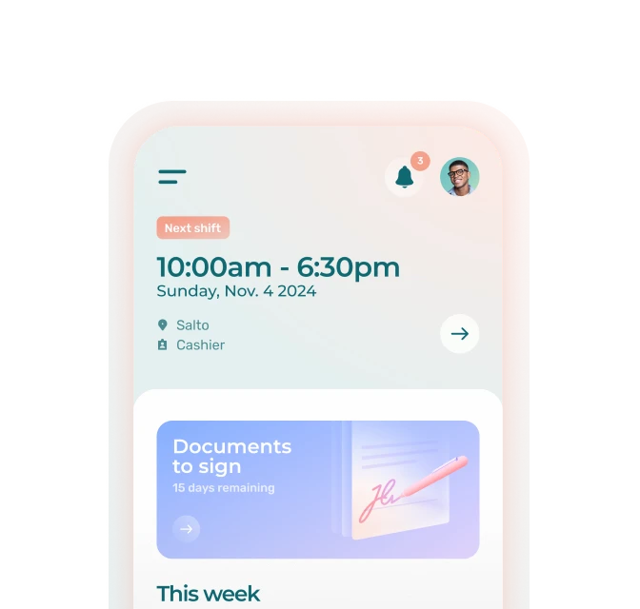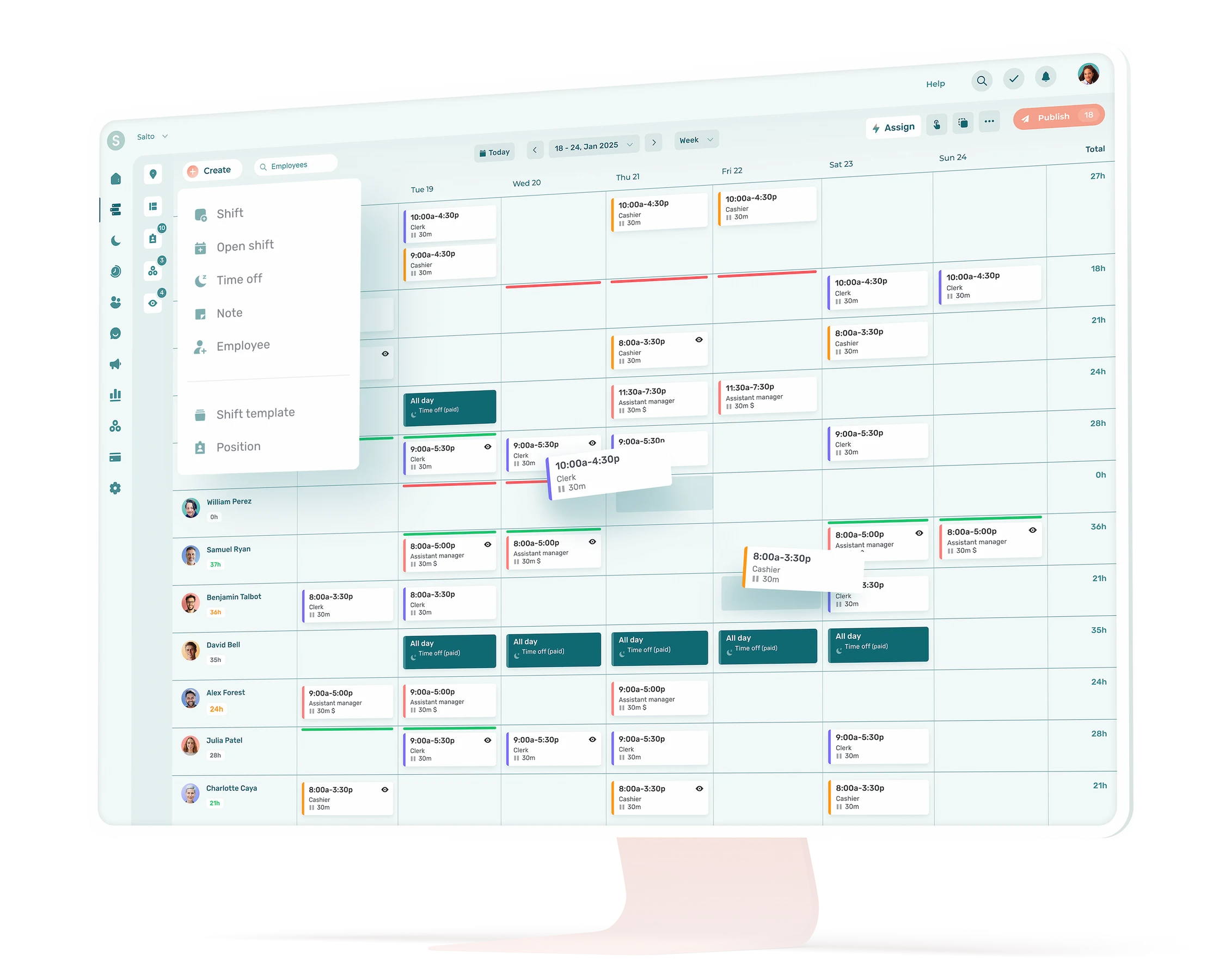When it comes to work schedules, employers have a number of obligations to meet—and things can quickly become thorny and confusing.
Responsibility for work schedules rests entirely on employers, who must make sure to comply with any legislation in effect. Companies’ obligations can vary greatly depending on their geographical location.
The managers who draw up schedules typically have to uphold legal working hours and rest periods. They also need to ensure that they offer their employees enough flexibility to strike a good balance between their work and personal lives. All of these management tasks can substantially impact employee satisfaction and retention.
Scheduling is therefore a crucial task for any type of business. Here’s a snapshot of your obligations as an employer.
What Should Be In a Work Schedule?
Typically, work schedules should contain at least the following:
- The time when employees start their shifts
- The time when employees finish their shifts
- The rest periods to which they are entitled (coffee and meal breaks)
- The dates concerned
Some employers may decide to add additional information, such as important messages, lists of tasks to be carried out according to the shift, and the type of day off (vacation, unpaid day off, mandatory time off, etc.).
What Form Should the Work Schedule Take?
The form of the work schedule is at the employer’s discretion. You can determine the form that best suits the needs of your company and your team.
For example, you can choose to create your work schedule using:
- An Excel work schedule template
- An online calendar
- A Word table
- Scheduling software
Work hours can be weekly, monthly or even yearly. Most companies that have to manage variable schedules and extended hours of operation opt for a weekly schedule for greater flexibility.
How Soon Should the Work Schedule Be Shared With Employees?
As a general rule, you should always try to share the work schedule as early as possible. It should also always be posted in the workplace and sent directly to employees. This way, they can check their schedule more easily and won’t have to travel to see it.
While you are not required to provide your employees with a copy of the schedule, this remains a best practice.
You can also use scheduling software to make it easier to share schedules. All you have to do is post the schedule, and your employees receive a notification that their new schedule is available.
And if you need to make any changes, only the employees concerned will be notified. This will avoid a great deal of confusion.
Most scheduling software also lets you check that your employees have viewed their schedules, which is very useful when managing a larger team.
In Quebec
Quebec does not adhere to any official time frame for sharing a work schedule. However, your employees have the right to refuse to work if they have not been informed of their schedule at least 5 days in advance, unless the nature of their work requires them to be available at all times.
For example, waiters in a restaurant may refuse to come in to work on Monday if their schedule was only shared with them the previous Friday.
So always make sure to share the schedule with your employees in advance, ideally with 2 weeks’ notice to give them more flexibility.
HR Best Practices
Respect your employees’ personal lives and avoid sharing schedules with them at the last minute. This is a frequent source of frustration for employees.
This can be avoided with a little prior organization. For example, you can create rotating schedules or use scheduling software to simplify your tasks.
How to Create a Work Schedule?
To build a helpful and effective work schedule, you need to have several crucial pieces of information handy. You need to know local labor requirements, but also your employees’ availability and preferences, and comply with all applicable laws.
Here are a few questions to ask yourself before drawing up your work schedule:
- How many employees are needed in each of the company’s positions to be able to function smoothly
- What are the busiest times of the year, when more employees are needed
- What is the maximum number of hours an employee can work per week (by law and according to their preferences)
- What is the availability of team members
- Are any employees unavailable on certain dates
- What is the minimum rest period to be offered to employees
- What holidays need to be observed
The best way to make your schedule is to keep all the information you need in one place, so you don’t have to go back and forth to find what you need.
Even though some still use work schedule templates, the biggest advantage of scheduling software is that you can program your schedule to comply with current legislation. This way, you can be sure of avoiding mistakes.
Rules Governing Work Hours
In Quebec
In Quebec, a normal work week is 40 hours (with some exceptions). Employees may work overtime, but it must be paid at time and a half by the employer.
For example, Mary, a cashier at your grocery store, has 40 hours of work scheduled this week. However, an employee is late for their shift, so you ask Mary to stay on an extra hour and she agrees. Her hour of work will therefore count as overtime and will have to be paid at time-and-a-half.
You don’t have to offer your employees coffee breaks, but they must have a 30-minute (unpaid) meal break after 5 consecutive hours of work. You also need to ensure that your employees have 32 consecutive hours of rest each week. Agendrix’s rest compliance feature helps you create schedules that meet these requirements by automatically flagging work shifts or weeks that would otherwise not meet them.
If you have employees aged 16 and under, you have other obligations to meet, such as prohibiting them from working between 11 p.m. and 6 a.m. the next morning, and not preventing them from attending classes. Read on to find out more about hiring young employees.
You must pay your employees for a minimum of 3 hours’ work if you ask them to report to work for a longer period but then ask them to leave before their 3 hours of work are up.
In Summary
- 40 hours of work per week maximum
- 30-minute meal break after 5 consecutive hours of work
- 32 consecutive hours off per week
For further information, visit the CNESST website.
HR Best Practices
You should still consider offering your employees at least a 10-minute break after 2 hours’ work so that they can get some rest. In addition, always try to give them 2 consecutive days off to help them strike a better balance between their work and personal lives.
Don’t forget to take your employees’ preferences and requests into account when it comes to their time off. You can decide to impose weeks of vacation, but letting your employees choose is a much better practice.
Remember, rested and happy employees are productive and loyal employees!
Pay special attention if you have students on your team. They may need to cut back on their work hours at the end of the semester in order to focus on their studies.
How to Protect Employee Data?
In Quebec, Bill 25 governs the protection of employees’ personal information. It is your responsibility as an employer to be aware of this and enforce the measures that apply.
For example, Quebec employers must:
- Appoint a privacy officer for the company
- Have a confidentiality-incident management plan and register
- Disclose any incidents threatening the confidentiality of private data, or a cyber attack
In Europe, the General Data Protection Regulation provides a framework for the protection of personal information. All European employers must comply with the laws in place.
To make sure you protect your employees’ data, properly lock the devices on which their personal information is available, and avoid sharing employees’ information with other staff members without their consent, for example.
Since these laws can be complicated and also involve the protection of your customers’ information, I strongly urge you to consult the official documentation to be sure that you are complying with the laws in effect in your region.
Keep Management Simple
Equip yourself with effective tools to streamline your management tasks and make sure you comply with all applicable laws. To do so, centralize your tasks in employee management software that lets you manage schedules, track working time, communicate with your team, recognize their good work, file staff records, and more.
This way, you’ll spend less time on administrative tasks and be able to concentrate on what really matters—your employees.










